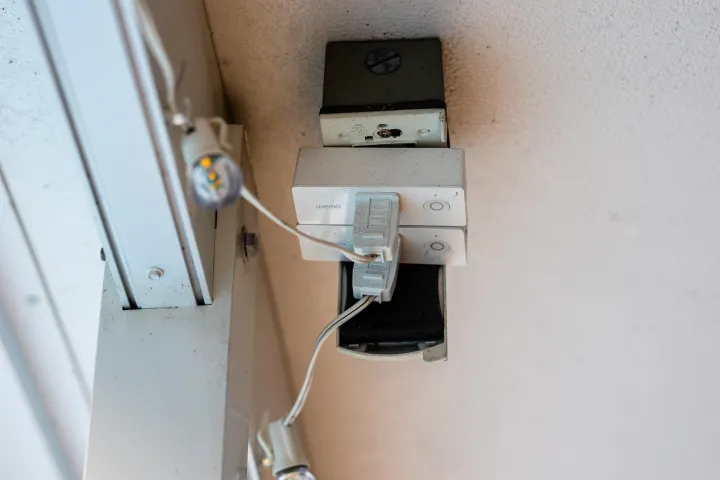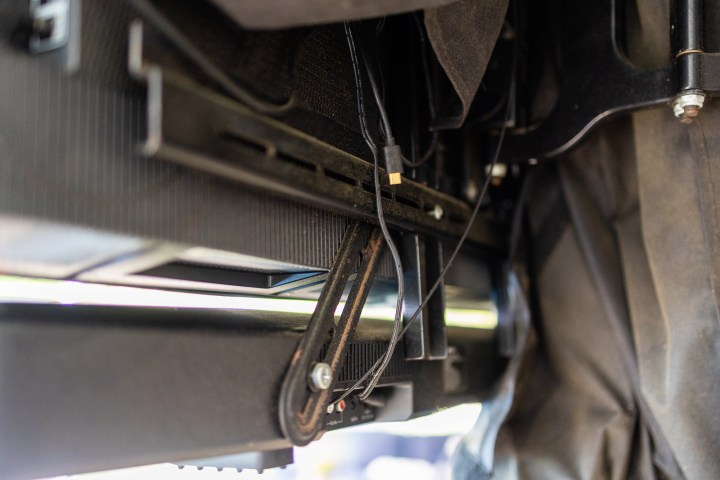Summer is here, once more. (Yes, again.) That means more time spent outside. In the sun. In the shade. In the pool. In the backyard. And while there’s definitely a time and a place for turning off the tech and simply enjoying being, one of the better decisions I’ve made in the past few years was to turn my backyard space into more of a proper entertainment space.
So when my wife and I opted to put in a pool in 2017, I had a few extras in mind. Namely, I wanted to be able to watch TV outdoors. Or maybe put some music on with something better than a relatively cheap Bluetooth speaker.
And the cool thing is that it was a relatively inexpensive setup. Here’s how I did it.

The infrastructure is important
First, a pretty serious caveat. My setup is going to be different from yours. And my concerns are going to be different than yours. So you’ll need to adapt this to your specific situation. Maybe you have to worry about long months in sub-freezing temperatures and something I’m told is called “snow.” (It looks like sand to those of us here in Florida, but whatever.) Maybe you’ve got more direct sun. Or less. The point is, take this and adapt it to your environment.
Two things you’re almost certainly going to need to figure out before you do anything else, however: Power, and Internet.
If you’re going to have a television outdoors, you’re going to need to get electricity to it somehow. The same goes for speakers or lights or whatever. That might require some new wiring. That might require some creative (temporary) extension cords. In my case, it was a relatively simple (though not at all inexpensive) part of the planning process. I knew where I wanted to put the TV. I knew where I’d probably want to put speakers and lights. So I had certified electricians install new outlets where I needed them.
And I can’t stress enough that unless you’re an electrician, this isn’t something you should attempt yourself. Electricity can mean fire. Fire is bad. Don’t be a hero. And building codes may differ from one location to another. Follow your local code.
Internet, however — that’s something I can handle. So I made sure I had a decent signal across the back porch. Again, that’s going to be pretty specific to your setup. But for what it’s worth, I’ve been running an Eero Pro 6
That’s the un-fun stuff. Here come the parts you have more control over.
The outdoor television
The only real requirement for what I was going to put outside was simplicity. It doesn’t need to be fantastic, just something to watch casually while we’re in the pool or on the porch. While 4K resolution is always better, it wasn’t a deal-breaker, especially. More important to me was going to be price.

Do a search for “outdoor television” and you’ll likely find something that claims to be great in full sun and has a screen and body that hold up to the elements. And it’s likely also pretty expensive given the relatively small sizes these outdoor TVs come in.
And that’s actually a really important point — do your homework first. Don’t just go buy a 65-inch TV without first making sure that it’ll fit wherever it is you’re going to mount it. I knew I had a space that was 51 inches wide, so the TV would need to fit inside that lest it block a window.
Back to that whole thing about looking at an “outdoor TV.” If you’ve got the money to spend on something that’s more likely to stand up to the elements better than not, go for it. You’ll maybe sleep just a little bit better at night.
But I’d recommend a different tack. Again, this depends a lot on where and how you’re mounting your TV. Mine is tucked up under the eve of the house, with another 10 feet or so of porch cover on top of it. Full sun isn’t an issue. Rain — something we tend to get a lot of here in Florida — also isn’t really an issue. My biggest concern really is humidity. And, it turns out, wasps. (The short version is that they love to make their little nest in the tiny recessed screw holes.)
So I got something that wasn’t going to break the bank — something that I wouldn’t feel too bad about replacing if things went horribly wrong somehow. I spent $250 on a TCL 3-Series back in 2019, and it still works just fine three years later. It’s a Roku TV, meaning it uses the Roku operating system and has access to all the streaming services I need, without having to plug in any other sticks or boxes. Less is more when it comes to electronics outside. But a TV with Amazon Fire TV or Google TV built in would work just fine, too.
- 1. If you’re going to have any sort of TV outside, definitely get a cover for it.
- 2. The articulating mount I use outdoors to make sure we can watch from any angle.
- 3. The plugs behind the TV.
- 4. How the soundbar mounts to the TV.
The TCL TV
I’m also using an articulating mount that ensures we can angle the TV toward wherever people might want to watch.
Optional — but something I’d recommend — is mounting a soundbar underneath it. I wouldn’t spend a whole lot of money here if all it’s going to do is run sound for the TV, but you can get something that’s perfectly adequate for maybe $100.
The outdoor speakers
I distinctly remember running what at the time seemed like miles of speaker wire as a kid. My dad was into that stuff. We went from one side of the house to the other. Through walls and rooms and wherever to get this newfangled compact-disc technology to where the earholes were. Later, we went through brick and mounted a couple of outdoor Bose speakers onto his back porch.
It’s far easier now.

I have a pair of first-generation Sonos Play:1 speakers out back, separated by about 30 feet. Just plug ’em in, and fire up Dire Straits as the sun goes down. One, seen here, is mounted to the brick. The other, below, is sitting on a shelf. The only wires you have to worry about are power cords. (Again, see the electricity part of this piece.)
Interestingly, this is the most expensive part of my setup. A new pair of Sonos One(s)

While I can’t speak to the longevity of Sonos One when left outdoors (and that’s not exactly something that the company would recommend you do), my first-gen speakers still work just fine out there after about five years of use, which is excellent.
Sure, there are tons of options when it comes to wireless speakers. You can spend more, or less. But the one thing I’d definitely recommend doing is setting up a stereo pair. A single Sonos One works great, but two paired together sound so much better.
Let there be light
This part is totally optional, but it’s fun. Outdoor lights set the mood. Maybe it’s a party. Maybe it’s romantic. Maybe it’s a romantic party.
Again, this probably will require an electrical outlet or two. So consider that while you’re planning things out. But you don’t necessarily need smart lights — which still tend to be pretty expensive.

I ended up going with two strands of white dumb lights connected to two Wemo smart outlets
(Fun story: I had to use smart outlets because when I had the electricians run the new outlets, I didn’t have them install switches for the ones that would power the lights. Whoops.)
There are plenty of alternatives to Wemo — use whatever you want. But the cool part is how they’ll automatically turn on as the sun comes up, and again later in the day when it starts to go down. And because it’s all connected it’s super easy to turn them on or off manually if the need arises — just use your voice.
The bottom line
You can spend as much — or as little — as you want on an outdoor theater experience. Mine’s not so much a theater as it is a way to watch TV and listen to music while we’re doing other things outside.

You’ll want to figure out what you want to do before you buy anything. Do you need to run new electrical? Do you have internet access of some sort? Will any electronics be relatively safe from the elements?
And how fancy do you want to get? Do you need the best TV you can possibly get? Or just something good enough to watch casually while you’re doing other things? Do speakers need to be mounted more permanently? Or do you just want to do something portable?
The sky’s the limit here. But one thing is for sure — it’s absolutely possible to bring the indoors outdoors.







